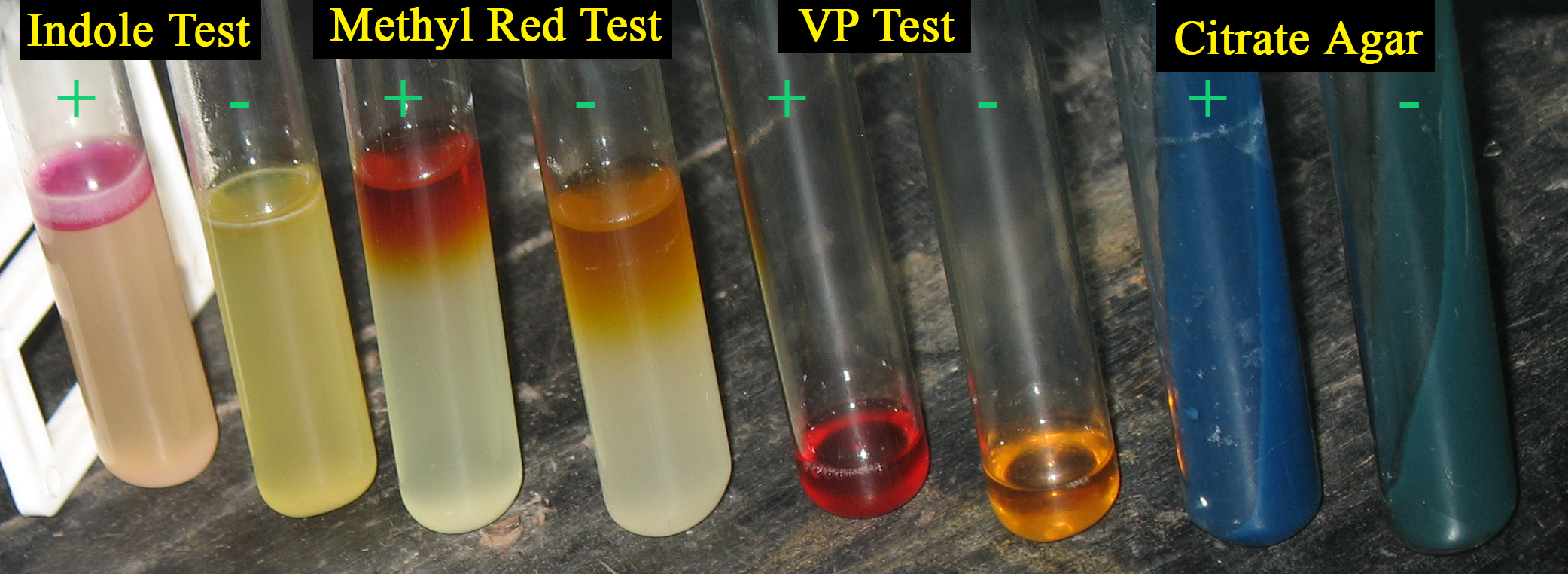IMViC on:
[Wikipedia]
[Google]
[Amazon]
The IMViC tests are a group of individual tests used in microbiology lab testing to identify an organism in the coliform group. A coliform is a 
gram negative
Gram-negative bacteria are bacteria that, unlike gram-positive bacteria, do not retain the crystal violet stain used in the Gram staining method of bacterial differentiation. Their defining characteristic is that their cell envelope consists of ...
, aerobic, or facultative anaerobic rod, which produces gas from lactose
Lactose is a disaccharide composed of galactose and glucose and has the molecular formula C12H22O11. Lactose makes up around 2–8% of milk (by mass). The name comes from (Genitive case, gen. ), the Latin word for milk, plus the suffix ''-o ...
within 48 hours. The presence of some coliforms indicate fecal contamination.
The term "IMViC" is an acronym for each of these tests. "I" is for indole test; "M" is for methyl red test; "V" is for Voges-Proskauer test, and "C" is for citrate test. The lower case "i" is merely for "in" as the Citrate test requires coliform samples to be placed "in Citrate".
These tests are useful in distinguishing members of Enterobacteriaceae
Enterobacteriaceae is a large family (biology), family of Gram-negative bacteria. It includes over 30 genera and more than 100 species. Its classification above the level of Family (taxonomy), family is still a subject of debate, but one class ...
.

Indole test
In this test, the organism under consideration is grown in peptone water broth. It containstryptophan
Tryptophan (symbol Trp or W)
is an α-amino acid that is used in the biosynthesis of proteins. Tryptophan contains an α-amino group, an α-carboxylic acid group, and a side chain indole, making it a polar molecule with a non-polar aromat ...
, which under the action of enzyme tryptophanase is converted to an Indole
Indole is an organic compound with the formula . Indole is classified as an aromatic heterocycle. It has a bicyclic structure, consisting of a six-membered benzene ring fused to a five-membered pyrrole ring. Indoles are derivatives of indole ...
molecule, pyruvate and ammonium. The indole is then extracted from the broth by means of xylene. The broth is sterilized for 15 minutes at around 121 °C. To test the broth for indole production, Kovac's reagent . Kovac's reagent consist of amyl alcohol and para-dimethylaminobenzaldehyde and concentrated hydrochloric acid
Hydrochloric acid, also known as muriatic acid or spirits of salt, is an aqueous solution of hydrogen chloride (HCl). It is a colorless solution with a distinctive pungency, pungent smell. It is classified as a acid strength, strong acid. It is ...
. Kovac's reagent is actually used to determine ability of an organism to separate indole from amino acid tryptophan and it is added after incubation. A positive result is indicated by a pink/red layer forming on top of the liquid.
Methyl red and Voges–Proskauer test
These tests both use the same broth for bacterial growth. The broth is called MR-VP broth. After growth, the broth is separated into two different tubes, one for the methyl red (MR) test and one for the Voges-Proskauer (VP) test. The methyl red test detects production of acids formed during metabolism using mixed acid fermentation pathway usingpyruvate
Pyruvic acid (CH3COCOOH) is the simplest of the alpha-keto acids, with a carboxylic acid and a ketone functional group. Pyruvate, the conjugate base, CH3COCOO−, is an intermediate in several metabolic pathways throughout the cell.
Pyruvic ...
as a substrate. The pH indicator Methyl Red is added to one tube and a red color appears at pH's lower than 4.2, indicating a positive test (mixed acid fermentation is used). The solution remaining yellow (pH = 6.2 or above) indicates a negative test, meaning the butanediol fermentation is used.
The VP test uses alpha-naphthol and potassium hydroxide
Potassium hydroxide is an inorganic compound with the formula K OH, and is commonly called caustic potash.
Along with sodium hydroxide (NaOH), KOH is a prototypical strong base. It has many industrial and niche applications, most of which utili ...
to test for the presence of acetylmethylcarbinol (acetoin), an intermediate of the 2,3-butanediol fermentation pathway. After adding both reagents, the tube is shaken vigorously then allowed to sit for 5–10 minutes. A pinkish-red color indicates a positive test, meaning the 2,3-butanediol fermentation pathway is used.
Citrate test
In the 1930's, S.A. Koser conducted experiments that were used to study bacterial catabolism of organic acids. Koser found that citrate metabolism could be an indicator for bacteria found in natural environments. Additionally, citrate could be used to distinguish bacterial coliforms found in soil, and aquatic environments, such as ''Enterobacteiacea'', and coilforms with fecal contamination. It was found that coilforms without fecal contamination grew, while the coilforms with fecal contamination did not grow. This test uses Simmon's citrate agar to determine the ability of a microorganism to use citrate as its sole carbon and energy source. The agar contains citrate and ammonium ions (nitrogen source) and bromothymol blue (BTB) as a pH indicator. Bromothymol blue was added in order to reduce false positives. The citrate agar is green before inoculation, and turns blue, because of BTB as a positive test indicator, meaning citrate is utilized. The test is also prepared on a slant to maximize bacterial growth for an even better indication of the use of citrate.Usage
These IMViC tests are useful for differentiating the familyEnterobacteriaceae
Enterobacteriaceae is a large family (biology), family of Gram-negative bacteria. It includes over 30 genera and more than 100 species. Its classification above the level of Family (taxonomy), family is still a subject of debate, but one class ...
, especially when used alongside the Urease test.
The IMViC results of some important species are shown below.
References